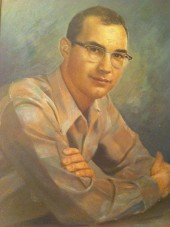April 18, 2008.
When driving down the highways of Texas, New Mexico, and Colorado, Ron, Paul and I talked.
The subject of Tony’s talking about how he met Don Slater came up and the question was: Did what he said contradict what Joe Hansen says in the biography, A Few Doors West of Hope?
I don’t think so. But a few things Tony said sounded to me like a few of Don’s (or worse, Dorr’s) sayings. For instance, I think Tony said he met Don in about 1955, which of course is not true, and that he might have 48 acres of property — which is not true, they started with what? 32 or 33 1/2, and he sold either four or 13 to Kevin (actually first to Susan of the house above him) and so has about 28, plus of course the house and the mobile home which he may try to rent out, minus the darn log cabin which managed to burn down. I say darn because the new owners of the Dutton “resort” asked to buy it back, and he refused. (National Geographic has an article on places and lists Dutton in it.) Don and I went there while “touring” the land above Dolores and toward Rico, in the old Studebaker.
So I am not sure that Dale Jennings was right. He left soon after anyway. But I doubt Don and Dorr would have just quit. But the issue shows how important others have been, in this case Eric Julber, as later on Herb Selwyn has been, etc. They would have had to change course, gone into “education” another way, but that might have been difficult since it was the magazine that brought in enough money to do the work, which in a sense caused the inevitable “separation” (since Dorr Legg, the practical one, etc., was the one who lost common sense and wanted to stop the magazine and just push the (at most quarterly) classes, etc.)
In a sense he did after we left, but he failed, even after getting the Institute’s accreditation. The magazine failed too, eventually, but not for quality but for being overtaken by newer, more “commercial” publications such as The Advocate, Drum, etc. But Dorr survived, as we knew he would, because of the money from ISHR/Reed, which of course then ended in a legal battle and splitting up, etc.
The only question today is: Can USC’s ONE Institute do its job — not only save the material but get it known about and used by scholars and students and the public? And the same is true for the HIC Archives.
Getting much of it on line is a good part of the answer.


